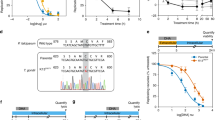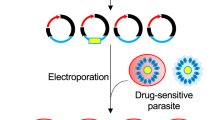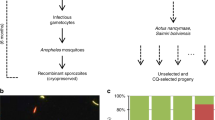Abstract
Studies of gene function and molecular mechanisms in Plasmodium falciparum are hampered by difficulties in characterizing and measuring phenotypic differences between individual parasites. We screened seven parasite lines for differences in responses to 1,279 bioactive chemicals. Hundreds of compounds were active in inhibiting parasite growth; 607 differential chemical phenotypes, defined as pairwise IC50 differences of fivefold or more between parasite lines, were cataloged. We mapped major determinants for three differential chemical phenotypes between the parents of a genetic cross, and we identified target genes by fine mapping and testing the responses of parasites in which candidate genes were genetically replaced with mutant alleles. Differential sensitivity to dihydroergotamine methanesulfonate (1), a serotonin receptor antagonist, was mapped to a gene encoding the homolog of human P-glycoprotein (PfPgh-1). This study identifies new leads for antimalarial drugs and demonstrates the utility of a high-throughput chemical genomic strategy for studying malaria traits.
This is a preview of subscription content, access via your institution
Access options
Subscribe to this journal
Receive 12 print issues and online access
$259.00 per year
only $21.58 per issue
Buy this article
- Purchase on Springer Link
- Instant access to full article PDF
Prices may be subject to local taxes which are calculated during checkout




Similar content being viewed by others
References
Snow, R.W., Guerra, C.A., Noor, A.M., Myint, H.Y. & Hay, S.I. The global distribution of clinical episodes of Plasmodium falciparum malaria. Nature 434, 214–217 (2005).
Noedl, H. et al. Evidence of artemisinin-resistant malaria in western Cambodia. N. Engl. J. Med. 359, 2619–2620 (2008).
Su, X.-z. & Wootton, J.C. Genetic mapping in the human malaria parasite Plasmodium falciparum. Mol. Microbiol. 53, 1573–1582 (2004).
Su, X.-z., Hayton, K. & Wellems, T.E. Genetic linkage and association analyses for trait mapping in Plasmodium falciparum. Nat. Rev. Genet. 8, 497–506 (2007).
Gardner, M.J. et al. Genome sequence of the human malaria parasite Plasmodium falciparum. Nature 419, 498–511 (2002).
Knockaert, M. et al. Intracellular targets of cyclin-dependent kinase inhibitors: identification by affinity chromatography using immobilised inhibitors. Chem. Biol. 7, 411–422 (2000).
Walliker, D. et al. Genetic analysis of the human malaria parasite Plasmodium falciparum. Science 236, 1661–1666 (1987).
Wellems, T.E. et al. Chloroquine resistance not linked to mdr-like genes in a Plasmodium falciparum cross. Nature 345, 253–255 (1990).
Hayton, K. et al. Erythrocyte binding protein PfRH5 polymorphisms determine species-specific pathways of Plasmodium falciparum invasion. Cell Host Microbe 4, 40–51 (2008).
Inglese, J. et al. Quantitative high-throughput screening: a titration-based approach that efficiently identifies biological activities in large chemical libraries. Proc. Natl. Acad. Sci. USA 103, 11473–11478 (2006).
Plouffe, D. et al. In silico activity profiling reveals the mechanism of action of antimalarials discovered in a high-throughput screen. Proc. Natl. Acad. Sci. USA 105, 9059–9064 (2008).
Pollock, L.A. Further experience with dihydroergotamine methanesulfonate in the treatment of migraine; with a note on the use of cafergone. Ann. West Med. Surg. 3, 388–390 (1949).
Mehrotra, S. et al. Current and prospective pharmacological targets in relation to antimigraine action. Naunyn Schmiedebergs Arch. Pharmacol. 378, 371–394 (2008).
Gangjee, A., Jain, H.D. & Kurup, S. Recent advances in classical and non-classical antifolates as antitumor and antiopportunistic infection agents: Part II. Anticancer. Agents Med. Chem. 8, 205–231 (2008).
Busch, A.E. et al. Blockade of epithelial Na+ channels by triamterenes - underlying mechanisms and molecular basis. Pflugers Arch. 432, 760–766 (1996).
Schaerlinger, B., Hickel, P., Etienne, N., Guesnier, L. & Maroteaux, L. Agonist actions of dihydroergotamine at 5–HT2B and 5–HT2C receptors and their possible relevance to antimigraine efficacy. Br. J. Pharmacol. 140, 277–284 (2003).
Foote, S.J. et al. Several alleles of the multidrug-resistance gene are closely linked to chloroquine resistance in Plasmodium falciparum. Nature 345, 255–258 (1990).
Reed, M.B., Saliba, K.J., Caruana, S.R., Kirk, K. & Cowman, A.F. Pgh1 modulates sensitivity and resistance to multiple antimalarials in Plasmodium falciparum. Nature 403, 906–909 (2000).
Sidhu, A.B., Valderramos, S.G. & Fidock, D.A. pfmdr1 mutations contribute to quinine resistance and enhance mefloquine and artemisinin sensitivity in Plasmodium falciparum. Mol. Microbiol. 57, 913–926 (2005).
Schalhorn, A., Siegert, W. & Sauer, H.J. Antifolate effect of triamterene on human leucocytes and on a human lymphoma cell line. Eur. J. Clin. Pharmacol. 20, 219–224 (1981).
Hayton, K. & Su, X.-z. Genetic and biochemical aspects of drug resistance in malaria parasites. Curr. Drug Targets Infect. Disord. 4, 1–10 (2004).
Kublin, J.G. et al. Molecular markers for failure of sulfadoxine-pyrimethamine and chlorproguanil-dapsone treatment of Plasmodium falciparum malaria. J. Infect. Dis. 185, 380–388 (2002).
Wu, Y. & Wellems, T.E. Transformation of Plasmodium falciparum malaria parasites by homologous integration of plasmids that confer resistance to pyrimethamine. Proc. Natl. Acad. Sci. USA 93, 1130–1134 (1996).
Su, X.-z. et al. A genetic map and recombination parameters of the human malaria parasite Plasmodium falciparum. Science 286, 1351–1353 (1999).
Hayton, K. & Su, X.-z. Drug resistance and genetic mapping in Plasmodium falciparum. Curr. Genet. 54, 223–239 (2008).
Mu, J. et al. Genome-wide variation and identification of vaccine targets in the Plasmodium falciparum genome. Nat. Genet. 39, 126–130 (2007).
Jeffares, D.C. et al. Genome variation and evolution of the malaria parasite Plasmodium falciparum. Nat. Genet. 39, 120–125 (2007).
Volkman, S.K. et al. A genome-wide map of diversity in Plasmodium falciparum. Nat. Genet. 39, 113–119 (2007).
Weisman, J.L. et al. Searching for new antimalarial therapeutics amongst known drugs. Chem. Biol. Drug Des. 67, 409–416 (2006).
Chong, C.R., Chen, X., Shi, L., Liu, J.O. & Sullivan, D.J. Jr. A clinical drug library screen identifies astemizole as an antimalarial agent. Nat. Chem. Biol. 2, 415–416 (2006).
Baniecki, M.L., Wirth, D.F. & Clardy, J. High-throughput Plasmodium falciparum growth assay for malaria drug discovery. Antimicrob. Agents Chemother. 51, 716–723 (2007).
Kato, N. et al. Gene expression signatures and small-molecule compounds link a protein kinase to Plasmodium falciparum motility. Nat. Chem. Biol. 4, 347–356 (2008).
Arastu-Kapur, S. et al. Identification of proteases that regulate erythrocyte rupture by the malaria parasite Plasmodium falciparum. Nat. Chem. Biol. 4, 203–213 (2008).
Wellems, T. et al. Chromosome size variation occurs in cloned Plasmodium falciparum on in vitro cultivation. Rev. Bras. Genet. 11, 813–825 (1988).
Rathod, P.K., McErlean, T. & Lee, P.C. Variations in frequencies of drug resistance in Plasmodium falciparum. Proc. Natl. Acad. Sci. USA 94, 9389–9393 (1997).
Cowman, A.F. & Karcz, S. Drug resistance and the P-glycoprotein homologues of Plasmodium falciparum. Semin. Cell Biol. 4, 29–35 (1993).
Price, R.N. et al. Mefloquine resistance in Plasmodium falciparum and increased pfmdr1 gene copy number. Lancet 364, 438–447 (2004).
Zimmerman, J., Selhub, J. & Rosenberg, I.H. Competitive inhibition of folic acid absorption in rat jejunum by triamterene. J. Lab. Clin. Med. 108, 272–276 (1986).
Montalar, M. et al. Kinetic modeling of triamterene intestinal absorption and its inhibition by folic acid and methotrexate. J. Drug Target. 11, 215–223 (2003).
Yuvaniyama, J. et al. Insights into antifolate resistance from malarial DHFR-TS structures. Nat. Struct. Biol. 10, 357–365 (2003).
Mu, J. et al. Multiple transporters associated with malaria parasite responses to chloroquine and quinine. Mol. Microbiol. 49, 977–989 (2003).
Trager, W. & Jensen, J.B. Human malaria parasites in continuous culture. Science 193, 673–675 (1976).
Liu, S., Mu, J., Jiang, H. & Su, X.-z. Effects of Plasmodium falciparum mixed infections on in vitro antimalarial drug tests and genotyping. Am. J. Trop. Med. Hyg. 79, 178–184 (2008).
Mu, J. et al. Chromosome-wide SNPs reveal an ancient origin for Plasmodium falciparum. Nature 418, 323–326 (2002).
Broman, K.W., Wu, H., Sen, S. & Churchill, G.A. R/qtl: QTL mapping in experimental crosses. Bioinformatics 19, 889–890 (2003).
Acknowledgements
This work was supported by the Divisions of Intramural Research at the National Institute of Allergy and Infectious Diseases, and by the National Human Genome Research Institute and the NIH Roadmap for Medical Research, all at the US National Institutes of Health. We thank J. Sa, J. Mu, L. Jiang, D. Raj and M.J. López Barragán for help in drug assays; P. Shinn and D. VanLeer for compound management; D. Leja for assistance in artworks and NIAID intramural editor B.R. Marshall for assistance.
Author information
Authors and Affiliations
Contributions
J.Y. performed drug assay qHTS, parasite culture and data analysis; R.L.J. performed assay optimization, qHTS and data analysis and helped write the manuscript; J.W. performed qHTS; R.H. performed data analysis; H.J. performed drug assays; K.H. performed progeny cloning and helped write the manuscript; D.A.F. transfected parasites and helped write the manuscript; T.E.W. produced progeny and helped write the manuscript; C.P.A. and J.I. planned the project and helped write the manuscript; X.-z.S. conceived the project, analyzed data and helped write the manuscript.
Corresponding author
Supplementary information
Supplementary Text and Figures
Supplementary Figures 1–5 and Supplementary Tables 1–13 (PDF 1271 kb)
Rights and permissions
About this article
Cite this article
Yuan, J., Johnson, R., Huang, R. et al. Genetic mapping of targets mediating differential chemical phenotypes in Plasmodium falciparum. Nat Chem Biol 5, 765–771 (2009). https://doi.org/10.1038/nchembio.215
Received:
Accepted:
Published:
Issue Date:
DOI: https://doi.org/10.1038/nchembio.215
This article is cited by
-
A single nucleotide polymorphism in the Plasmodium falciparum atg18 gene associates with artemisinin resistance and confers enhanced parasite survival under nutrient deprivation
Malaria Journal (2018)
-
Plasmodium falciparum chloroquine resistance transporter (PfCRT) isoforms PH1 and PH2 perturb vacuolar physiology
Malaria Journal (2016)
-
PfCRT and PfMDR1 modulate interactions of artemisinin derivatives and ion channel blockers
Scientific Reports (2016)
-
Chemical signatures and new drug targets for gametocytocidal drug development
Scientific Reports (2014)
-
Disrupting malaria parasite AMA1–RON2 interaction with a small molecule prevents erythrocyte invasion
Nature Communications (2013)



